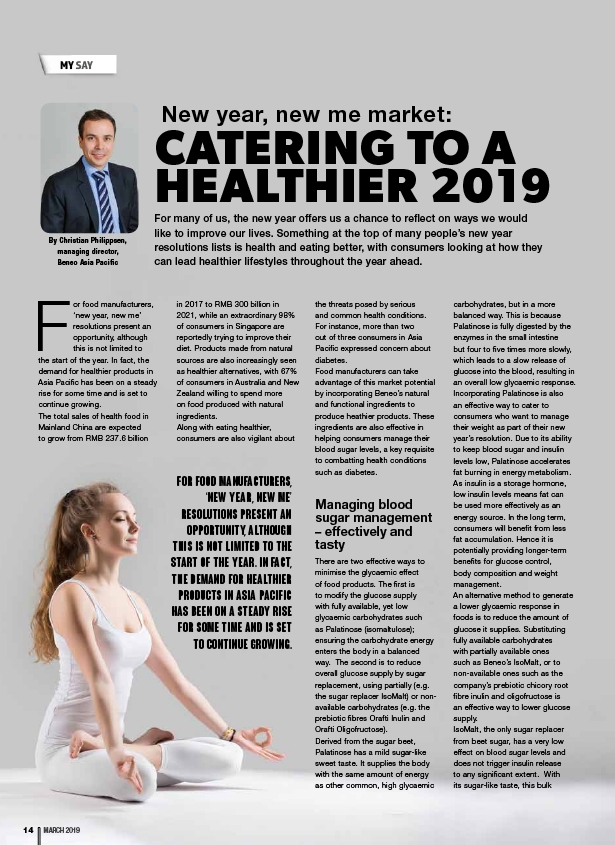
CATERING TO A
HEALTHIER 2019
For many of us, the new year offers us a chance to reflect on ways we would
like to improve our lives. Something at the top of many people’s new year
resolutions lists is health and eating better, with consumers looking at how they
can lead healthier lifestyles throughout the year ahead.
For food manufacturers,
‘new year, new me’
resolutions present an
opportunity, although
this is not limited to
the start of the year. In fact, the
demand for healthier products in
Asia Pacific has been on a steady
rise for some time and is set to
continue growing.
The total sales of health food in
Mainland China are expected
to grow from RMB 237.6 billion
New year, new me market:
in 2017 to RMB 300 billion in
2021, while an extraordinary 98%
of consumers in Singapore are
reportedly trying to improve their
diet. Products made from natural
sources are also increasingly seen
as healthier alternatives, with 67%
of consumers in Australia and New
Zealand willing to spend more
on food produced with natural
ingredients.
Along with eating healthier,
consumers are also vigilant about
By Christian Philippsen,
managing director,
Beneo Asia Pacific
the threats posed by serious
and common health conditions.
For instance, more than two
out of three consumers in Asia
Pacific expressed concern about
diabetes.
Food manufacturers can take
advantage of this market potential
by incorporating Beneo’s natural
and functional ingredients to
produce heathier products. These
ingredients are also effective in
helping consumers manage their
blood sugar levels, a key requisite
to combatting health conditions
such as diabetes.
Managing blood
sugar management
– effectively and
tasty
There are two effective ways to
minimise the glycaemic effect
of food products. The first is
to modify the glucose supply
with fully available, yet low
glycaemic carbohydrates such
as Palatinose (isomaltulose);
ensuring the carbohydrate energy
enters the body in a balanced
way. The second is to reduce
overall glucose supply by sugar
replacement, using partially (e.g.
the sugar replacer IsoMalt) or nonavailable
carbohydrates (e.g. the
prebiotic fibres Orafti Inulin and
Orafti Oligofructose).
Derived from the sugar beet,
Palatinose has a mild sugar-like
sweet taste. It supplies the body
with the same amount of energy
as other common, high glycaemic
carbohydrates, but in a more
balanced way. This is because
Palatinose is fully digested by the
enzymes in the small intestine
but four to five times more slowly,
which leads to a slow release of
glucose into the blood, resulting in
an overall low glycaemic response.
Incorporating Palatinose is also
an effective way to cater to
consumers who want to manage
their weight as part of their new
year’s resolution. Due to its ability
to keep blood sugar and insulin
levels low, Palatinose accelerates
fat burning in energy metabolism.
As insulin is a storage hormone,
low insulin levels means fat can
be used more effectively as an
energy source. In the long term,
consumers will benefit from less
fat accumulation. Hence it is
potentially providing longer-term
benefits for glucose control,
body composition and weight
management.
An alternative method to generate
a lower glycaemic response in
foods is to reduce the amount of
glucose it supplies. Substituting
fully available carbohydrates
with partially available ones
such as Beneo’s IsoMalt, or to
non-available ones such as the
company’s prebiotic chicory root
fibre inulin and oligofructose is
an effective way to lower glucose
supply.
IsoMalt, the only sugar replacer
from beet sugar, has a very low
effect on blood sugar levels and
does not trigger insulin release
to any significant extent. With
its sugar-like taste, this bulk
For food manufacturers,
‘new year, new me’
resolutions present an
opportunity, although
this is not limited to the
start of the year. In fact,
the demand for healthier
products in Asia Pacific
has been on a steady rise
for some time and is set
to continue growing.
MY SAY
14 MARCH 2019